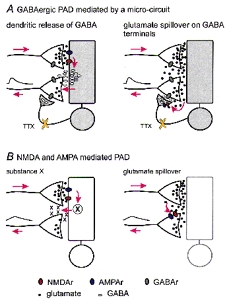Figure 4.

Possible mechanisms for the DRP generated by a non-spiking micro-circuit
In the four diagrams the proposed flow of signals from action potentials in stimulated primary afferents to DRPs recorded in other primary afferents is indicated by red arrows. A, the GABAergic component of the TTX-resistant DRP may be mediated by GABA released from dendrites (left) or from GABAergic terminals excited by glutamate spillover (right). B, the glutamate component may be produced indirectly by release of substance X (left) or by spillover of glutamate from neighbouring terminals (right). NMDAr, NMDA receptor; AMPAr, AMPA receptor; GABAr, GABA receptor. TTX-resistant DRP at 50T. C, Mg2+ sensitivity of TTX- and CNQX-resistant DRP at 50T. Ca, reduction of TTX-resistant DRP (control) by 25 μm CNQX (CNQX). Cb, recovery of TTX- and CNQX-resistant DRP by eliminating Mg2+ (0 Mg2+ + CNQX). Cc, 40 μm bicuculline (Bic + 0 Mg2+ + CNQX) blocks the early component of the CNQX-resistant DRP in the absence of Mg2+ while the remaining DRP is blocked by 100 μm AP-5 (AP-5 + Bic + 0 Mg2+ + CNQX). A, B and C are from different preparations. All recordings were obtained in the presence of 150 nm TTX.
